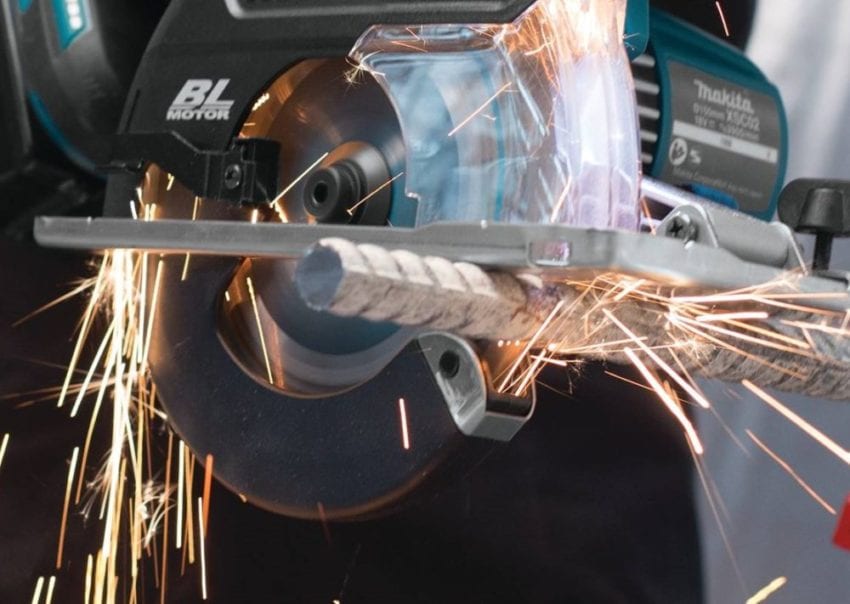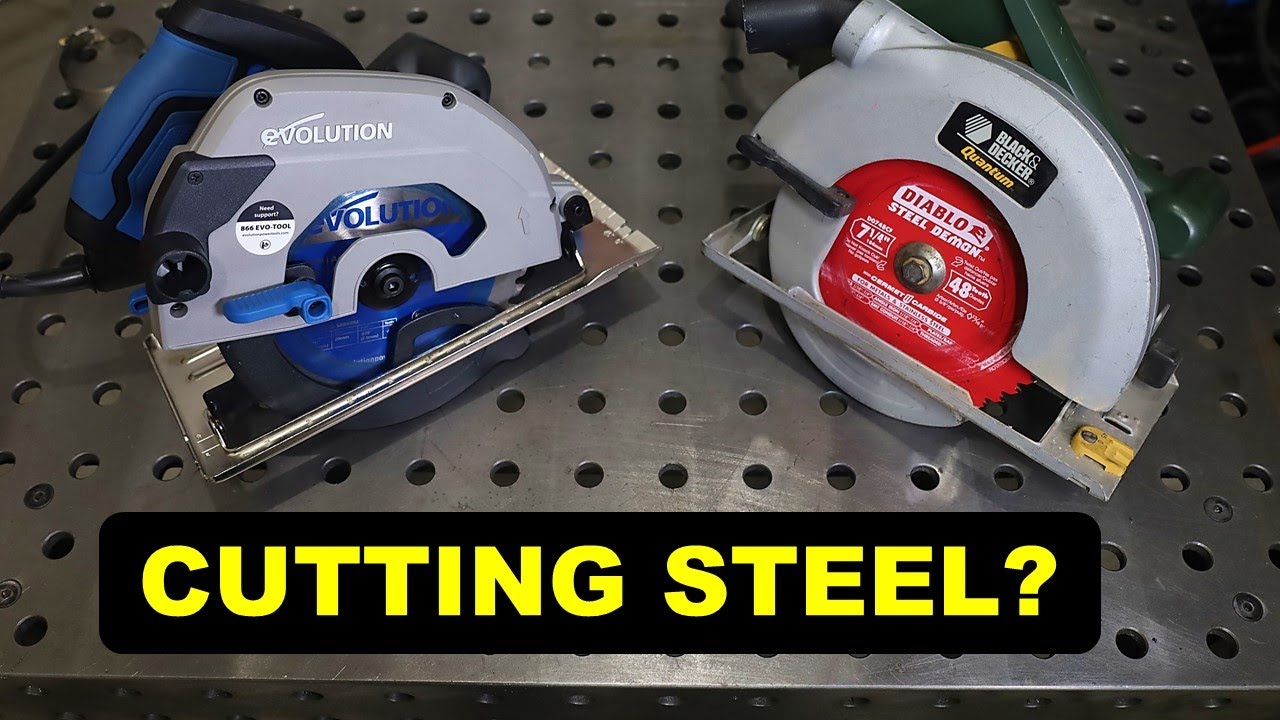Curious about whether a circular saw can be used to cut metal? Well, you’ve come to the right place! In this article, we’ll delve into the world of circular saws and discover if they have what it takes to tackle metal-cutting tasks. So, buckle up and let’s dive in!
Imagine this scenario: you’re working on a DIY project and need to cut through a sheet of metal. You take a look at your trusty circular saw and wonder, “Can this tool handle the job?” That’s a great question, and one that many people have pondered. Today, we’ll explore whether a circular saw, typically used for cutting wood, has the chops for cutting metal too.
Metal cutting usually requires specialized tools, like oxy-acetylene torches or abrasive saws. But can you get away with using a circular saw? That’s what we’re here to find out. Join us as we dig deeper into the capabilities of circular saws and uncover if they can handle the heat when it comes to cutting metal. Let’s get started!
1. Choose the right blade for metal cutting.
2. Secure the metal piece firmly.
3. Mark the cutting line.
4. Wear safety goggles and gloves.
5. Go slowly and let the blade do the work.
Remember to practice caution and prioritize safety when using a circular saw for cutting metal.

Can a Circular Saw Be Used to Cut Metal?
Introduction: Circular saws are versatile tools that are commonly used for cutting wood and other materials. But can they be used for cutting metal? In this article, we will explore the capabilities of circular saws when it comes to cutting metal and discuss the pros and cons of using these saws for this purpose. Whether you’re a professional tradesperson or a DIY enthusiast, understanding the limitations and benefits of using a circular saw to cut metal can help you make informed decisions and ensure safety in your projects.
1) The Basics: Can a Circular Saw Cut Metal?
Circular saws are primarily designed for cutting lumber, but with the right blade and the appropriate adjustments, they can be used to cut through some types of metal as well. However, it is important to note that not all circular saws are suitable for cutting metal, and using the wrong saw or blade can lead to poor results and even accidents. To cut metal effectively, you will need a circular saw with enough power, the appropriate blade, and the ability to adjust the speed and cutting depth. It is also crucial to take safety precautions such as wearing protective gear and using clamp or vise to secure the metal piece.
Choosing the Right Blade
When it comes to cutting metal with a circular saw, the type of blade you use is crucial. Regular wood-cutting blades will not be effective at cutting metal and can quickly become dull or even break. The most suitable blade for metal cutting is a carbide-tipped blade specifically designed for cutting ferrous and non-ferrous metals. These blades have specialized teeth that can withstand the heat and friction caused by cutting through metal. It is important to select a blade with the appropriate number of teeth for the thickness of the metal you are cutting. A high tooth count is recommended for thin metals, while a lower tooth count is suitable for thicker metals.
2) Advantages of Using a Circular Saw to Cut Metal
Using a circular saw to cut metal offers several advantages, making it a viable option for certain applications. Firstly, circular saws are readily available and widely used, which means you may already have one in your toolkit. This eliminates the need to invest in a specialized metal-cutting tool, saving you both money and storage space. Secondly, circular saws allow for precise and straight cuts, especially when equipped with a guide or using a straightedge. This makes them suitable for applications such as cutting metal sheets or pipes, where accuracy is essential. Lastly, circular saws provide a significant power advantage compared to handheld tools like tin snips or hacksaws, allowing for faster and more efficient cutting.
Tips for Using a Circular Saw to Cut Metal
To ensure the best results when using a circular saw to cut metal, follow these tips:
1. Use a carbide-tipped blade designed for metal cutting.
2. Adjust the saw’s cutting depth to avoid excessive heat and friction.
3. Secure the metal piece firmly using clamps or a vise to prevent movement during cutting.
4. Wear appropriate safety gear, including gloves, safety glasses, and ear protection.
5. Take breaks to allow the saw and blade to cool down, especially during prolonged cutting.
3) Limitations and Alternatives
While circular saws can be used for cutting metal, there are limitations to consider. Firstly, the power and RPM of a circular saw may not be sufficient for cutting thicker or harder metals. For heavy-duty or industrial metal cutting, specialized tools such as reciprocating saws, plasma cutters, or angle grinders may be more suitable. These tools are specifically designed for metal cutting and offer higher power, speed, and precision. Additionally, circular saws may produce more sparks and generate more heat compared to dedicated metal-cutting tools, potentially causing damage to the saw or the metal being cut. It is important to assess the specific requirements of your project and choose the appropriate tool accordingly.
Safety Considerations
When using a circular saw to cut metal, it is crucial to prioritize safety. Here are some important safety considerations:
1. Wear protective gear, including safety glasses, gloves, and ear protection.
2. Secure the metal piece firmly using clamps or a vise to prevent movement during cutting.
3. Be cautious of sparks and take appropriate fire safety measures.
4. Work in a well-ventilated area to prevent inhalation of metal dust or fumes.
5. Follow the manufacturer’s instructions and guidelines for your specific circular saw and blade.
Conclusion
In conclusion, while circular saws can be used to cut metal with the right blade and appropriate adjustments, it is important to understand their limitations and take necessary safety precautions. Circular saws are versatile tools that provide straight and precise cuts, making them suitable for certain metal-cutting applications. However, for heavy-duty or industrial metal cutting, specialized tools are recommended. By considering the pros and cons, choosing the right blade, and following safety guidelines, you can effectively and safely use a circular saw to cut metal.
Can a Circular Saw be Used to Cut Metal?
- A circular saw can be used to cut metal, but it requires a specific blade designed for cutting metal.
- The metal-cutting blade has a finer tooth count compared to blades used for cutting wood.
- It’s important to use the right blade for the material you are cutting to ensure clean and accurate cuts.
- Circular saws are best suited for cutting thin metals like aluminum or sheet metal.
- For thicker metals like steel, a different type of saw or cutting tool may be more appropriate.
Frequently Asked Questions
Are you wondering if a circular saw can be used to cut metal? Check out these commonly asked questions to learn more.
1. Can I use a circular saw to cut metal sheets?
Yes, a circular saw can be used to cut metal sheets, but you need to have the correct blade for the job. Most circular saws are designed for cutting wood, so using them on metal requires a different type of blade. Look for a carbide-tipped blade specifically designed for cutting metal, as it will have a stronger and more durable cutting edge. Remember to wear protective gear, such as safety glasses and gloves, and take appropriate safety precautions when working with metal.
Furthermore, when cutting metal sheets with a circular saw, it’s essential to set the right cutting speed. Slower cutting speeds are recommended for metal to ensure a clean and precise cut. Keep in mind that metal sheets tend to produce more sparks and heat compared to cutting wood, so be cautious and maintain a steady cutting pace.
2. Can I cut pipes and tubes with a circular saw?
Yes, a circular saw can be used to cut pipes and tubes, but you should use a blade specifically designed for cutting metal. When cutting pipes or tubes, make sure to properly secure them in a bench vise or clamp to prevent movement during cutting. Always measure and mark the desired cutting line on the pipe or tube before making the cut. Additionally, be cautious of any sparks or metal filings that may be produced during the cutting process. It’s important to wear protective gear and have proper ventilation in the work area.
Keep in mind that cutting pipes and tubes requires a different technique compared to cutting flat metal sheets. It’s recommended to use a cutting guide or a pipe cutting attachment for accurate and precise cuts. Following the manufacturer’s instructions and taking the necessary safety precautions will help you achieve a successful cut.
3. What types of metals can a circular saw cut?
A circular saw can cut various types of metals, including steel, aluminum, brass, copper, and more. However, it’s crucial to use the appropriate blade for the specific metal you’re cutting. Different metals require different blade materials and tooth configurations to ensure efficient and clean cuts. Research and choose the right blade for the metal you intend to cut to achieve the best results.
Additionally, factors such as the thickness of the metal and the cutting speed should be taken into consideration. Thicker metals will require a more powerful saw and a slower cutting speed. Always refer to the blade manufacturer’s recommendations and adjust your cutting technique accordingly.
4. Can a circular saw be used for precision metal cuts?
While circular saws are versatile tools, they may not provide the same level of precision as other tools, such as a bandsaw or a plasma cutter, when it comes to intricate metal cuts. Circular saws are more suitable for straight cuts and larger sections of metal. For precision work, it’s recommended to use specialized tools designed explicitly for detailed metal cuts. However, with the right blade, proper technique, and practice, a circular saw can still produce satisfactory precision cuts.
If you require precise cuts in metal, it’s worth considering alternative tools or techniques that can provide more accuracy and control, especially for intricate or delicate projects. Always assess the specific requirements of your project and choose the appropriate tool accordingly.
5. Do I need to use a lubricant when cutting metal with a circular saw?
Using a lubricant while cutting metal with a circular saw can help improve the cutting process. Lubricants reduce friction and heat, which can prolong the life of the blade and provide smoother cuts. There are specific cutting oils and lubricants available that are formulated for metal cutting applications.
When using a lubricant, apply it directly to the cutting area or use lubricant sticks specifically designed for sawing metal. The lubricant will help cool the blade and reduce the chance of it getting stuck or binding during the cut. Always follow the manufacturer’s instructions and safety guidelines when using any type of lubricant.

Summary
Circular saws are not designed for cutting metal because they have high speeds and thin blades. Metal requires slower speeds and specialized blades to prevent damage and ensure safety. Using a circular saw on metal can cause the blade to become dull quickly, overheat, and even break, leading to accidents. It is best to use a saw specifically designed for cutting metal to get accurate and clean cuts while maintaining safety.
